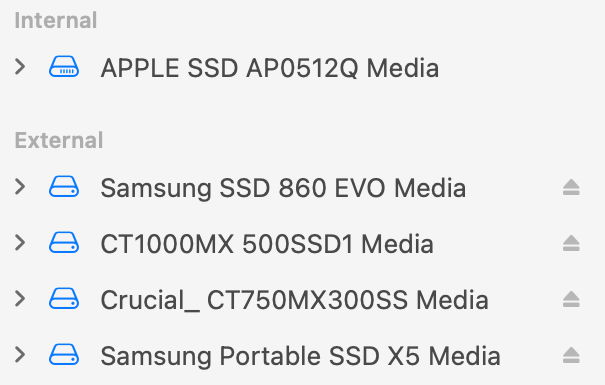Almost as soon as I got my first Mac with a Thunderbolt port, I started looking for a hub to let me to connect more devices than I had ports. At first, with Thunderbolt 1, I was fobbed off with stories that, as this was almost exclusive to Apple and would never catch on, there was no demand for them. So it went on, more briefly with Thunderbolt 2, and now with Thunderbolt 3/4. Until the last few months, when the first TB 3/4 hubs have finally appeared, at least in the US.
First there was CalDigit’s Element Hub, which won’t be available outside the USA until “early June”, a date that’s already slid to the right.
Then I came across the Kensington SD5700T Thunderbolt 4 Dual 4K Dock, which again wasn’t available in Europe or former European dropouts like the UK. Having finally got my hands on one (yes, I bought it like anyone else), I’ve been testing it out.
The Kensington Dock is quite a hefty peripheral. Because of its power requirements, its 20 V power supply is almost as big as the dock itself, and if anything slightly heavier. This is inescapable if it’s going to be able to meet the demands of its ports, though. If you want something comparable to lightweight and undemanding USB hubs, you’re going to be shocked with their Thunderbolt equivalents. That’s the price of progress.
The Ports

One face of the dock has the 20 V DC power input, three USB-C sockets offering both USB-C and Thunderbolt 3/4, an Ethernet socket (up to 1 Gbps), and three USB-A sockets supporting 3.2 Gen2 at up to 10 Gbps.

The other face has an SD 4.5 card slot, a USB-A 2.0 socket supporting BC 1.2 and “Apple charging”, a headphone socket, the Thunderbolt 3/4 port for connection to the host computer, a couple of status lights and the power button.
It’s worth noting that, when these docks and hubs claim four Thunderbolt ports, that always seems to include the port you have to use to connect it to your Mac. In reality, they consume one port on your Mac to provide three on the dock/hub, which isn’t quite as attractive as it might appear.
The dock is supplied with a 0.8 m Thunderbolt 4 cable to connect it to your Mac, the power supply and its mains cables.
Does it work with an M1 Mac?
Yes. Because of the limited options for displays with current M1 Macs, I didn’t look at the dock’s support for external displays, but concentrated on its support for external SSDs, including their ability to be used to boot an M1 Mac mini.


With a single Kensington dock, I was able to connect and use a total of four external SSDs: three connected to the USB-C/TB4 ports on the dock, and the fourth to the remaining port on the mini itself. Only one of these, the Samsung X5, is a TB3 disk, the others all being SATA disks with USB-C.
Among those external SSDs I have two bootable versions of Big Sur, of 11.2.1 and 11.3.1. The first of those is USB-C/SATA and normally used on the mini’s USB-A ports, the other on the Samsung X5. While the latter remained fully bootable, the disk with 11.2.1 installed couldn’t be used as a startup disk when connected to the Kensington dock, whether via one of its USB-C/TB4 ports or USB-A. This suggests that M1 Secure Boot sees all disks connected to the dock as being Thunderbolt devices, and despite that disk having the appropriate Reduced Security setting, wouldn’t recognise it.

Thus a Thunderbolt hub or dock complicates the already complicated security issues with external bootable disks and M1 Macs. If you’re looking to boot your M1 Mac from a disk connected to a hub or dock, be prepared for some trouble if not a straight refusal. Connecting an external boot disk direct to a port on your Mac is more reliable.
Thunderbolt 3 SSD performance
I’ve now run a lot of speed tests using my app Stibium on this Samsung X5 SSD. Results are fairly consistent, so long as it doesn’t suffer from thermal throttling during write testing. I was therefore surprised that its write performance was considerably poorer when connected via this dock, compared to when connected direct to the M1 mini. Read speed was, though, unaffected.
Write testing returned a transfer rate of only 1.3 GB/s, with a peak of around 1.6 GB/s, when connected to the dock, compared to a transfer rate of just over 2 GB/s and a peak of 2.4 GB/s when connected directly to a TB4 port on the mini. Read speeds were identical though, at 2.6 GB/s whether the SSD was connected direct or via the dock. That’s a big reduction in write speed, to around 65%, and not that far above far cheaper SATA/USB-C models.
I can’t explain how this impaired write performance occurred, and hope that others with experience using Thunderbolt hubs/docks can suggest whether it’s more general.
Verdict
If you have more Thunderbolt and USB-C disks than ports, this Kensington Dock is one of very few options at present. It’s not cheap by any means, typically costing around £/$/€ 300, but it does offer a good range of ports which are valuable to any Mac user. My only two other reservations are the increased complexity and reduced reliability with bootable external disks, and the strange performance decrement when writing to a connected SSD.
I’m not sure how often I’m going to use this now that I have finally got what I’ve been wishing for all these years. But with few alternatives, it’s an essential accessory for anyone with more Thunderbolt devices than ports. If only it didn’t cost more than 40% of a basic M1 Mac mini.

